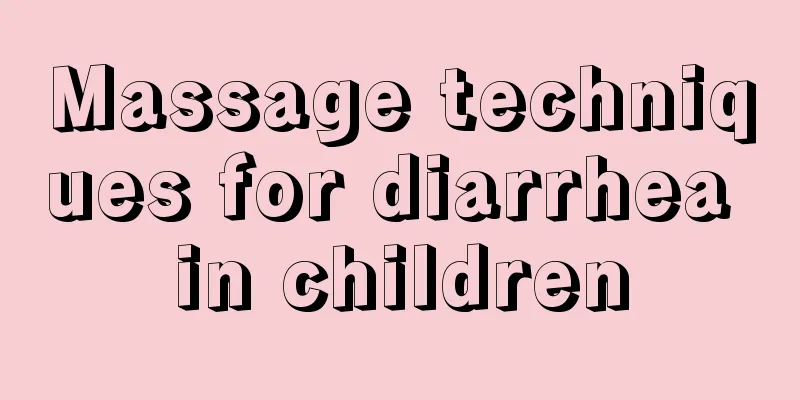What are the common diseases and care of newborns?

|
Neonatal disease is a stubborn disease and has certain difficulties in treatment, but this should not discourage confidence in treatment. During the treatment, the care of neonatal diseases must be done well. So how should we care for common neonatal diseases? Friends who don’t understand, let’s learn together how to care for neonatal diseases. Symptoms: If the baby's weight is more than 20% higher than the normal value for children of the same age, gender and height, he or she may be considered obese. The main reason for baby obesity is parents' one-sided pursuit of nutrition, which leads to overnutrition. If a baby eats too much, especially too many sweets and snacks, and too much staple food, and exercises too little, the calories in the diet will exceed the body's normal needs for a long time. The excess calories will be stored as fat. If there is too much fat accumulation, the weight will increase. Therefore, this condition is also called simple obesity or nutritional obesity. Solution: First, find the cause. If it is simple obesity, the starting point of care should basically be from two aspects: diet and exercise. That is, control your diet and increase your exercise. Let your baby exercise as much as possible every day. There is no fixed amount and time of exercise. Every baby has different personality and physique. It is appropriate to do it in a way that does not make the baby tired. In terms of diet, do not force your child to eat like a duck. Before 3 months old, about 120-150CC of milk is needed for every kilogram of body weight. In addition to maintaining the original amount of milk for 4 to 6 months, you can add rice porridge, oatmeal porridge or fruit juice and other complementary foods for the baby, about half a bowl a day. This data can only be used as a reference. The specific amount for each child will definitely be different. Parents should observe more. If they feel that the child is full, there is no need to force him or her to eat. In addition to simple obesity, some babies may be obese due to endocrine diseases. At this time, treatment is needed under the guidance of a doctor. Parenting tips: Generally, obese children aged 2 to 3 years old can play with a ball, ride a tricycle, and play hide-and-seek outdoors. Preschool children can skip rope, swim, play ball, run, etc. You can also do gymnastics, bending exercises, leg lifts, push-ups, sit-ups, etc. These exercises are very effective for weight loss and you must do them every day. If conditions permit, you can join group weight loss classes. Caring for a grooved tongue Symptoms: The surface of the tongue of most people is flat, without obvious protrusions or depressions. However, some people have vertical and horizontal grooves on their tongues, and these grooves may gradually become more severe with age. There is generally no discomfort with grooved tongue, but deep grooves may cause irritation and pain, but no treatment is required. The cause of this disease is unclear and is often considered to be congenital. It may also be related to geographical conditions, vitamin deficiency, and food type. Treatment method: If your baby has grooved tongue, pay attention to oral hygiene, keep the mouth clean, and prevent oral infections. Prevention and care of external auditory canal furuncle Symptoms: The human external auditory canal is rich in hair follicles and glands. Once the skin of the external auditory canal is damaged, it is easy to cause infection, and furunculosis is also prone to occur after infection. Furuncles in the external auditory canal are very painful. Babies often experience symptoms such as violent crying, refusing to drink milk, restless sleep, and being easily startled and crying because of this disease. Treatment method: In order to prevent the baby from developing external auditory canal furunculosis, keep the baby's external auditory canal clean, and do not use hairpins, matchsticks, etc. to remove the baby's "earwax"; when washing the face and hair, you can use a sterilized cotton ball to plug the ear canal opening to prevent water from entering the ear; if water enters the baby's ear, you can gently roll the sterilized cotton into the ear and wipe it. If your baby's ear canal is infected or has eczema, you must go to the hospital for examination and receive treatment under the guidance of a doctor. Prevention and care of constipation Symptoms: The symptoms of baby constipation are: infrequent bowel movements, some babies only defecate once every 3 to 4 days, and the stool is hard, defecation is difficult, there is pain or discomfort during defecation, and the baby cries. Baby constipation Generally speaking, babies who are fed with milk are prone to constipation. This is because the high casein content in cow's milk can make the stool dry. In addition, due to insufficient food intake or over-refined food with little fiber, there are less residues after digestion and less feces, which cannot form sufficient defecation stimulation to the intestines, causing feces to stay in the intestine for too long, which can also cause constipation. Some babies do not develop the habit of regular bowel movements and can also suffer from constipation. Or the baby may have certain diseases, such as anal stenosis, anal fissure, congenital megacolon, fever, etc., which can also cause constipation. Treatment: Don’t worry too much about constipation without any symptoms of disease. If the baby is fed with milk, adding appropriate amount of sugar (5% to 8% sucrose) to the milk can soften the stool; make sure to give the baby more fresh fruit juice, vegetable juice, and vegetable puree; the baby should not eat too refined food, but food rich in fiber, such as cabbage puree, corn paste, lettuce puree, etc., to facilitate the formation of stool. In addition, you should also pay attention to training your baby to develop a good habit of regular bowel movements. Once this habit is formed, even if there is not much stool, the time factor will serve as a stimulus and cause bowel movement. If the baby has not defecated for two days and is crying and irritable, parents can insert a suppository into the baby's anus, squeeze the medicine into the anus, remove the plastic tube, and gently pinch the anus to prevent the suppository from spraying out due to excessive pressure in the rectum before it takes effect. This method has a good laxative effect, but it should not be used frequently. Prevention is the main approach to baby constipation, and attention should be paid to diet and lifestyle habits. Daily care for rickets Symptoms: In the early stages of rickets, neuropsychiatric symptoms may appear, such as being easily frightened, crying, restless sleep, sweating, etc. There may also be occipital baldness (a circle of hairless on the back of the head), respiratory tract infection, anemia, etc. If not treated in time, it may cause bone and muscle diseases, such as ping-pong ball-like skull softening, large fontanelle, widened cranial sutures, delayed tooth eruption, and hypoplastic enamel. After the baby learns to walk, he may develop bow legs or X-shaped legs. Delayed closure of the fontanelle may also affect the baby's memory and comprehension. Treatment: Rickets is mainly about prevention. The simplest and most effective way is to do more outdoor activities and get more sun exposure. In addition, insist on breastfeeding. Although the calcium and phosphorus content in breast milk is low, the proportion is appropriate, which is conducive to the baby's absorption. In addition, vitamin D can be supplemented, because calcium can only be absorbed when the baby has enough vitamin D in the body. Therefore, in order to prevent rickets, babies should start supplementing vitamin D 2 to 3 weeks after birth, especially premature babies or twins. They can also take cod liver oil and calcium supplements until the age of 2. Some babies do not take cod liver oil, but take "Icoxin" or "Guteling". These two capsules only contain vitamin D, which is actually very helpful in preventing rickets. It also has a certain effect. Parents should be reminded here that when their baby shows signs of excessive sweating, restless sleep, and baldness on the back of the head, they should seek medical treatment as soon as possible and not wait until bone changes occur before taking it seriously. Prevention and care of iron deficiency anemia Symptoms: The period from birth to one year old is the most vigorous growth and development period for babies, during which blood volume increases rapidly. Iron is an important raw material for hemoglobin and myoglobin in the human body. Insufficient iron intake will cause iron deficiency anemia, which will affect oxygen transport and growth and development. Infants usually develop iron deficiency anemia between 6 months and 2 years old. Any baby under 6 years old with hemoglobin below 11 grams can be diagnosed with anemia. Treatment method: The iron stored in the liver that the baby obtains from the mother can only meet the needs of growth and development within 4 months. Babies from 4 to 6 months old gradually grow up and need to supplement 10 mg to 20 mg of iron every day to meet their needs. The iron contained in either human milk or cow's milk cannot meet this requirement, so it is necessary to add iron-rich complementary foods in time, such as egg yolks, animal liver, lean meat and green leafy vegetables. You can also use iron-fortified foods approved by the health authorities. In addition, hemoglobin should be checked regularly. Once iron deficiency anemia occurs, you should take medication under the guidance of a doctor. Prevention and care of cerebral palsy Symptoms: Motor dysfunction and abnormal posture are the main manifestations of cerebral palsy and are the main basis for diagnosis. Children with epilepsy and convulsions are prone to it, with an incidence rate of about 14%. Frequent attacks not only affect intelligence and learning ability, but also aggravate brain damage. In addition, about 5% of the children are completely deaf and suffer from language development disorders; about 30% to 70% will have language disorders, due to the motor dysfunction of the children's mouth and throat, leading to delayed language development and personality defects; about 55% to 60% of children with cerebral palsy have combined visual impairment, such as strabismus, amblyopia, hemianopsia, incoordination between hand, eye and brain, spatial vision, stereoscopic perception, and physical perception; about 50% of children with cerebral palsy have low intelligence, of which 25% of children have an IQ below 50. Emotional, behavioral and mental developmental disorders, manifested as timidity, withdrawal, inferiority complex, and mental retardation. Treatment method: There are many causes of cerebral palsy and the impact is serious. The key is early detection and early intervention. If the baby has cerebral palsy, adults should pay attention to adjusting their mindset and actively treat the baby. At the same time, they should give the baby more care in life, psychologically, and in terms of safety. Prevention and care of cold and asthma Symptoms: Generally, one or two days after a cold, runny nose, and fever, some babies will start coughing, and asthma will occur as the coughing gradually increases. The baby's exhalation is prolonged and breathing is rapid, reaching more than 50 times per minute, and the baby may even hold his breath. The mother can clearly feel that the baby's airway is blocked, and the lips turn blue when coughing or wheezing. Treatment method: The best care for asthma is actually prevention. Strengthen physical exercise, increase outdoor activities, enhance the baby's body resistance to disease, and reduce colds; dress appropriately, do not fluctuate between hot and cold, and if there are patients with upper respiratory tract infections at home, they should be isolated from the baby as much as possible. If you have to contact the baby, it is best to wear a mask; in addition, start with the home air, ventilate regularly, do not keep the room temperature too high or too low, and maintain a certain humidity; when grilling food indoors, be sure to open the window; prevent the baby from contacting small animals, and do not keep cats and dogs at home. In addition, dust mites are the most important allergen that triggers asthma attacks in children. You should pay attention to some small living habits. Be sure to fold the quilt after getting up every day, do not buy stuffed toys and plush toys for your baby, and avoid using carpets and tapestries at home. If necessary, the baby can be vaccinated for prevention. The attenuated virus vaccine can be sprayed or dripped into the nasal cavity to prevent or alleviate the symptoms of upper respiratory tract infection. The best way to treat a baby who has already developed asthma is to take the child to the hospital. Prevention and care of recurrent respiratory tract infections Symptoms: The most important feature of recurrent respiratory tract infections is that babies often catch colds, almost once a month, and it is particularly difficult to recover from a cold, which lasts for a long time. How to deal with it: In life, don’t always worry about your child being cold, always dress him in thick clothes and cover him too tightly, and don’t add or remove clothes immediately when the temperature changes slightly. There may be many reasons for children's recurrent respiratory tract infections. The better approach is to prescribe the right medicine and intervene under the guidance of a doctor. A comprehensive examination can be done under the doctor's advice, such as: the immune function of the blood (humoral immunity and cellular immunity) and the immune function of the respiratory mucosal surface. If the patient has immune deficiency, immunostimulation therapy can be carried out based on the test results, using thymosin, transfer factor, etc. Those with humoral immunity deficiency can use an appropriate amount of immunoglobulin G. Nursing care for seizures Symptoms: The most common cause of convulsions (commonly known as seizures) in babies over 6 months old is vitamin D deficiency tetany. This disease occurs in infancy, and the incidence rate in babies aged 3 to 6 months accounts for almost two-thirds. Because babies are in the fastest growth and development stage, they need relatively more calcium. If there is a lack of calcium in the diet, and the lack of vitamin D results in less calcium absorption, it is easy to have convulsions due to low calcium. This type of convulsion occurs several times a day, each lasting only a few seconds to a few minutes. Sometimes the attack is not a whole-body convulsion, but just a slight tremor of the eye muscles, facial muscles, or fingers and toes. When there is no attack, the patient's spirit and diet are normal, and there is no fever. There is another type of convulsion that often occurs between 6 months and 3 years old. It usually occurs when a high fever suddenly occurs at the beginning of a cold. Convulsions that occur after several days of fever are often considered to have other causes, such as meningitis, toxic encephalopathy, etc. Of course, these diseases are very serious and have their own special clinical manifestations. Treatment method: If your baby develops tetany, go to the hospital for diagnosis and treatment as soon as possible. Appropriate supplementation of calcium and vitamin D will quickly cure the disease without any sequelae. While preparing to send the child to the hospital, first aid should be performed at home: parents and caregivers should first remain calm and not panic. The baby should be quickly placed on the bed, laid flat on his back, with his buttons, collar and belt unbuttoned, and physical methods used to cool him down. Pinch the Ren Zhong point with your fingernails (the Ren Zhong point is located at the junction of the upper 1/3 and lower 2/3 of the nasolabial groove), tilt the baby's head to one side to prevent sputum from being inhaled into the trachea and causing suffocation, and use chopsticks wrapped in cloth or small wooden chips to stuff between the baby's upper and lower teeth to prevent the tongue from being bitten and ensure ventilation. When your baby is having a convulsion, you should not feed him water or food to avoid it entering his trachea and causing suffocation and pneumonia. While treating the condition at home, it is best to seek medical treatment nearby first. The convulsions will usually stop after an injection of sedative and antipyretic injections. Avoid running long distances to a large hospital, as this will cause the convulsion to be uncontrolled in the short term, leading to brain hypoxia, cerebral edema and even brain damage in the baby, ultimately affecting the baby's intelligence and even causing death in some children. After the baby stops seizures, he should go to the hospital in time to get a clear diagnosis and avoid delaying treatment. Care for baby's night sweats Symptoms: Sweating is normal, especially for babies due to their active metabolism. Children are active and some cannot rest even after going to bed at night, so they may sweat on their heads after falling asleep. The so-called physiological hyperhidrosis refers to sweating during sleep when the child is well-developed, healthy, and has no disease. Some pathological sweating occurs when the child is in a quiet state, such as sweating caused by rickets, which manifests as obvious sweating on the child's head in the first half of the night after falling asleep. Because the pillow is irritated by sweat, babies often shake their heads and rub against the pillow when they sleep, resulting in sparse hair and hair loss on the pillow, forming typical occipital annular hair loss, which is medically known as "occipital baldness" and is an early manifestation of rickets in infants. If a child sweats not only in the first half of the night but also in the second half of the night and before dawn, it is usually a sign of illness, the most common of which is tuberculosis. Tuberculosis also has other symptoms, such as low fever, fatigue, loss of appetite, flushed cheeks, etc. Children with tuberculosis tend to sweat easily during daytime activities, which is called spontaneous sweating, and sweating at night is called night sweats. Heart disease, diabetes (hypoglycemia), tuberculosis or breathing problems during sleep may cause the sympathetic nerves to be in a state of tension all the time due to the internal pressure (lesions) of the body, which may also cause "night sweats" or "cold sweats on hands and feet". These are long-term symptoms. Treatment method: Children's sweating during sleep should be carefully distinguished. If necessary, take the child to the hospital to check trace elements and treat any abnormalities in time. If you suspect your baby is sweating because of tuberculosis infection, you should do a lung X-ray or a tuberculin test for timely diagnosis and treatment. If you suspect your baby is sweating because of heart disease, diabetes (hypoglycemia), tuberculosis, or difficulty breathing during sleep, if parents are worried, they can take the baby to a pediatric clinic or hospital for a check-up to listen to the heartbeat for abnormalities, feel the belly for lumps (tumors), check whether the upper respiratory tract is unobstructed or whether the baby has allergies, etc., to eliminate any doubts in their minds. The above is a brief introduction to common diseases and care for newborns. I believe everyone is clear about it. It is not scary to have neonatal diseases. What is important is that we have the determination to get rid of neonatal diseases. As long as we treat it carefully and provide good care during the treatment, we will definitely be able to get rid of neonatal diseases. During the treatment of neonatal diseases, it will not only help the treatment of neonatal diseases, but also reduce the harm of neonatal diseases to themselves, allowing patients with neonatal diseases to get rid of pain as soon as possible. |
<<: Symptoms of trace element deficiency in children
>>: What are the dietary treatments for bronchitis in children?
Recommend
The newborn suddenly has no bowel movement for a day
If a newborn suddenly does not have a bowel movem...
4 month old baby convulsions
Every change in the baby after birth is watched b...
Newborns sometimes have blank eyes.
Newborns are the apple of their parents' eyes...
Is it normal for a baby to have growing teeth first?
When the baby is just born, he will not have teet...
Reasons why 1-year-old babies are restless when sleeping
Parents will find that many babies are always aff...
What should I do if my child always has allergies?
Some people are born with sensitive constitutions...
Why can't children grow meat even if they eat?
In daily life, children's physical developmen...
Why is my child always thirsty?
Children often feel thirsty, which is normal in s...
Symptoms of foreign matter in baby's nose
Babies are very curious about everything and have...
What to do if your 11-month-old baby can't crawl
Baby crawling is actually a very important thing ...
Causes of white spots on children's neck
If white spots appear on your smooth neck, it is ...
How long is the shelf life of diapers?
In order to make it more convenient for parents a...
Why does my baby have diarrhea after eating taro?
Taro is cheap in the market and has high nutritio...
Can children drink turtle soup?
Because turtle soup is a tonic food, it is not re...
How to prevent and care for sleep disorders in children?
Normal people sleep through the night, and some p...









